Solar physicists operating the NASA Solar Dynamics Observatory (SDO) announce the detection of a new solar flare, which began to form at 1:13 am EDT (0513 GMT) and peaked at 1:58 am EDT (0658 GMT), on July 19, 2012.
The flare was classified as an M7.7-class event, meaning it was of medium intensity, weaker than X-class flares, but more energetic than M-class one. It triggered a coronal mass ejection (CME) that could deal a glancing blow to our planet.
Experts at the US National Oceanic and Atmospheric Administration's (NOAA) Space Weather Prediction Center say that the highly energetic particles within the CME will not impact Earth directly, but they could affect our planet marginally.
There is a chance that GPS and communications signals being emitted or received at the poles will be scrambled by the CME, but there is currently no way of knowing that for sure.

 14 DAY TRIAL //
14 DAY TRIAL //